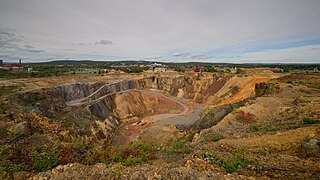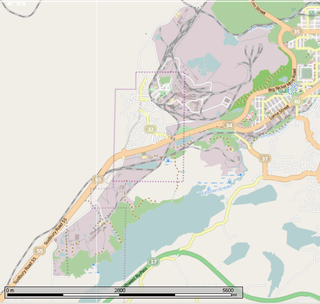
The Atacama Region is one of Chile's 16 first order administrative divisions. It comprises three provinces: Chañaral, Copiapó and Huasco. It is bordered to the north by Antofagasta, to the south by Coquimbo, to the east by the provinces of Catamarca, La Rioja and San Juan of Argentina, and to the west by the Pacific Ocean. The regional capital Copiapó is located 806 km (501 mi) north of the country's capital of Santiago. The region occupies the southern portion of the Atacama Desert, the rest of the desert is mainly distributed among the other regions of Norte Grande.

Chuquicamata is the largest open pit copper mine in terms of excavated volume in the world. It is located in the north of Chile, just outside Calama, at 2,850 m (9,350 ft) above sea level. It is 215 km (134 mi) northeast of Antofagasta and 1,240 km (770 mi) north of the capital, Santiago. Flotation and smelting facilities were installed in 1952, and expansion of the refining facilities in 1968 made 500,000 tons annual copper production possible in the late 1970s. Previously part of Anaconda Copper, the mine is now owned and operated by Codelco, a Chilean state enterprise, since the Chilean nationalization of copper in the late 1960s and early 1970s. Its depth of 850 metres (2,790 ft) makes it the second deepest open-pit mine in the world, after Bingham Canyon Mine in Utah, United States.

The National Copper Corporation of Chile, abbreviated as Codelco, is a Chilean state-owned copper mining company. It was formed in 1976 from foreign-owned copper companies that were nationalised in 1971.

Kennecott Utah Copper LLC (KUC), a division of Rio Tinto Group, is a mining, smelting, and refining company. Its corporate headquarters are located in South Jordan, Utah. Kennecott operates the Bingham Canyon Mine, one of the largest open-pit copper mines in the world in Bingham Canyon, Salt Lake County, Utah. The company was first formed in 1898 as the Boston Consolidated Mining Company. The current corporation was formed in 1989. The mine and associated smelter produce 1% of the world's copper.
Boliden AB is a Swedish multinational metals, mining, and smelting company headquartered in Stockholm. The company produces zinc, copper, lead, nickel, silver, and gold, with operations in Sweden, Finland, Norway, and Ireland.
Grupo México is a Mexican conglomerate that operates through the following divisions: Mining, Transportation, Infrastructure and Fundacion Grupo Mexico.

The Arizona Eastern Railway is a Class III railroad that operates 206 miles (332 km) of railroad between Clifton, Arizona, and Miami, Arizona, in the United States. This includes trackage rights over the Union Pacific Railroad between Lordsburg, New Mexico, and Bowie, Arizona. The railroad serves the copper mining region of southeastern Arizona, and the agricultural Gila River Valley. The railroad offers a transload location for lumber, building materials and other consumer commodities at Globe, Arizona, and can handle railcars weighing up to 286,000lbs. As of 2023, AZER has one interchange, with Union Pacific in Lordsburg, New Mexico.

Chañaral is a small coastal city and commune in the Atacama Region, Chile and capital of the Chañaral Province. Despite it being coastal, it is not a seaside resort, partly because the ocean is contaminated by the copper mining industry. Situated a short distance to the north is the Pan de Azúcar National Park.

La Oroya is a city on the River Mantaro and capital of the Yauli Province, located in the Department of Junin in central Peru. It is situated on the eastern watershed of the Andes at an altitude of 3,745 m, some 176 km east-north-east of the national capital, Lima. La Oroya is the location of a smelting operation that earned the town a place on the Blacksmith Institute's 2007 report on "The World's Worst Polluted Places". It is also the eastern endpoint of the Central Highway of Peru.

The Saudi Railways Organization (SRO) was a state-owned railway company that operated part of Saudi Arabia's rail network, along with the Saudi Railway Company. The SRO operated a network of railways with a total length of approximately 1,380 kilometers. The network consisted of two main lines. A 449 km passenger line that links Dammam with Riyadh, and a 556 km freight line that connects the King Abdul Aziz Port in Dammam with Riyadh.

The EMD GP49 is a 4-axle diesel locomotive built by General Motors Electro-Motive Division. Power was provided by an EMD 645F3B 12-cylinder engine which generated 2,800 horsepower (2.09 MW). The GP49 was marketed as one of four models in the 50 series introduced in 1979. The 50 series includes GP/SD49 and GP/SD50. Both the GP and SD50 were relatively popular with a total of 278 GP50s and 427 SD50s built. The SD49 was advertised but never built and a total of nine GP49s were built.

The EMD G12 is a class of export locomotive built by GM-EMD, and its Canadian affiliate General Motors Diesel. In addition, Australian licensee Clyde Engineering built ten locomotives for New Zealand in 1957, five for Hong Kong, 23 for Queensland, fourteen for Western Australia and seven for BHP. Australian licensee Commonwealth Engineering also built 42 for Queensland Rail in 1964–1966. Many examples were built in the 1950-1960s for railroads around the world.

Løkken Verk is a village in the municipality of Orkland in Trøndelag county, Norway. It is located 5 kilometres (3.1 mi) south of the village of Svorkmo, 2 kilometres (1.2 mi) east of the village of Bjørnli, and 10 kilometres (6.2 mi) north of the municipal center of Meldal.

In the United States, copper mining has been a major industry since the rise of the northern Michigan copper district in the 1840s. In 2017, the US produced 1.27 million metric tonnes of copper, worth $8 billion, making it the world's fourth largest copper producer, after Chile, China, and Peru. Copper was produced from 23 mines in the US. Top copper producing states in 2014 were Arizona, Utah, New Mexico, Nevada, and Montana. Minor production also came from Idaho and Missouri. As of 2014, the US had 45 million tonnes of known remaining reserves of copper, the fifth largest known copper reserves in the world, after Chile, Australia, Peru, and Mexico.

El Salvador is a mining town in the commune of Diego de Almagro, Chañaral Province, Atacama Region, Chile. Located at an elevation of more than 2,400 meters in the foothills of the Andes and in the middle of the Atacama Desert, it has a population of approximately 7,000 inhabitants. At its peak, El Salvador once had a population of 34,000 inhabitants.

Falun Mine was a mine in Falun, Sweden, that operated for a millennium from the 10th century to 1992. It produced as much as two-thirds of Europe's copper needs and helped fund many of Sweden's wars in the 17th century. Technological developments at the mine had a profound influence on mining globally for two centuries. The mine is now a museum and in 2001 was designated a UNESCO World Heritage Site.

The history of rail transport in Chile has gone through several periods of boom and bust. It began in 1840, with the construction by William Wheelwright of the first branch in the north. Further construction proceeded apace linking cities from Pisagua all the way to Puerto Montt.

The Vale Railway, formerly the INCO Railway, is an industrial railway operating in the City of Greater Sudbury, Ontario, Canada. It is owned and operated by Vale Limited.

The Salta–Antofagasta railway, also named Huaytiquina, is a non-electrified single track railway line that links Argentina and Chile passing through the Andes. It is a 1,000 mmmetre gauge railway with a total length of 941 km, connecting the city of Salta (Argentina) to the one of Antofagasta (Chile), on the Pacific Ocean, passing through the Puna de Atacama and Atacama Desert.
The heavy-haul railways in the Pilbara are a series of company-owned railways in the Pilbara region in the north-west of the state of Western Australia. Their routes total 2782 kilometres.



























